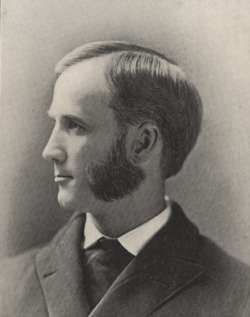 |
 |
John.
B. Finch,
Party Chairman (1884-1887)
John B. Finch, Chairman of the Prohibition National Committee 1884-1887, was born on 17 March 1852, the third son in a family of eight children. His parents were farmers near Lincklaen, New York.
Finch early on was attracted to intellectual pursuits, especially to temperance. He began teaching school in 1870 (at age 16) and began lecturing on temperance in 1873.
He married Retta L. Coy in 1871. Retta died of heart faiure in 1874. In 1876, Finch married Frances E. Manchester, gave up teaching, and became a travelling organizer for the International Organization of Good Templars.
Photo by Fritz Giehl, courtesy of Per-Hugo Kristensson
The second Mrs. Finch also did organizing for the IOGT. The Finches moved to Nebraska in 1877, lecturing and founding new lodges. Frances Finch became General Superintendent of Juvenile Lodges in Nebraska in 1879.
John B. Finch became influential in the Prohibition Party soon after its founding. He claimed that the Prohibition Party threw the 1887 national election to the Republicans, by siphoning off Democratic voters.
Finch died in 1887, of a heart attack, in Lynn, Massachusetts, while on an IOGT speaking tour of New England. He is buried in Chicago, at Rose Hill Cemetery. The IOGT erected there a substantial monument to Finch, at which Jupiter Lodge #3 conducts an annual Memorial Day service.
The cemetery is at Ravenswood and Western avenues, at the north edge of Chicago (Peterson Avenue exit from I-94 or from Lake Shore Drive). From the main entrance, on Ravenswood, turn right immediately and go to Section 91—the extreme NE corner of the cemetery.
Also at the Rose Hill are the IOGT Memorial (Section H) and Frances Willard's grave (nearby).
For a comprehensive biography of John B. Finch, see: Frances E. Finch and Frank James Sibley (1888) -- John B. Finch, His Life and Work: NYC, Funk & Wagnalls.
The subject of this sketch, John Bird Finch, was born in Lincklaen, New York on 17 March 1852 and died, of heart disease, in Boston, Massachusetts on 3 October 1887. After leaving school, he taught for several years, being at one time principal of the Union School at Smyrna, New York. He then studied law and was admitted to the bar at the age of 24.
Mr. Finch began active temperance work at an early age. When but 15 years old he joined the Good Templars and very soon had become grand lodge lecturer for the State of New York. In 1877 he removed to Lincoln, Nebraska and lectured in the interest of the Red Ribbon movement with great success, over 125,000 persons signing the pledge in less than two years,. He advanced rapidly to posts of honor among the Good Templars, being elected Grand Worthy Counselor of the Nebraska Grand Lodge, then Grand Worthy Chief Templar of the State of Nebraska, and finally, in 1884 Right Worthy Grand Templar of the Order in the United States. While occupying the last-named position, he was instrumental in bringing about the union of the two factions into which the Order had split in 1876.
Originally a Democrat, Mr. Finch united with the Prohibition Party in 1880 and was soon recognized as its ablest and most judicious leader. His addresses were notable for eloquence and force. His debate with Dio Lewis on “Prohibition” and his reply to D. Bethune Duffield at Detroit are among his best efforts. Most of his addresses have been collected and published in a book entitled, “The People vs the Liquor Trade (New York, 1887). In 1884, he was elected Chairman of the National Prohibition Committee, a position which he held until the time of his death, despite his frequently expressed wish to retire. He steadily refused to become a candidate for office.
In 1871, at the age of 19, Mr. Finch married Retta Coy, who died four years later. In 1876, he married Frances E. Manchester, who survives him. Mrs. Finch has, with the coöperation of her husband’s colaborer, Frank J. Sibley, published an interesting history of his career (“John B. Finch,” New York, 1888)
— Data from An Album of Representative Prohibitionists (1895)
[BACK]